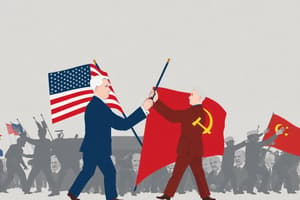Podcast
Questions and Answers
Match the following events with their descriptions during the Cold War:
Match the following events with their descriptions during the Cold War:
Berlin Wall = Symbol of division between East and West Germany Domino Theory = Prediction of the spread of Communism in Southeast Asia Cuban Missile Crisis = Major confrontation over Soviet missiles in Cuba Vietnam War = US military intervention to prevent Communist dominance
Match the following leaders with their associated countries during the Cold War:
Match the following leaders with their associated countries during the Cold War:
Ngo Dinh Diem = South Vietnam John F. Kennedy = United States Ho Chi Minh = North Vietnam Leonid Brezhnev = Soviet Union
Match the following concepts with their relevance in Southeast Asia:
Match the following concepts with their relevance in Southeast Asia:
Guerrilla Warfare = Tactics used by Communist forces in Vietnam Proxy War = Conflict where major powers support opposing sides Civilian Casualties = Toll of innocent lives during the Vietnam War Peace Talks = Attempts to negotiate an end to hostilities in Vietnam
Match the following military events with their significance in the Vietnam War:
Match the following military events with their significance in the Vietnam War:
Match the following treaties with their purpose related to Asia during the Cold War:
Match the following treaties with their purpose related to Asia during the Cold War:
Match the following propaganda tools with their functions during the Cold War:
Match the following propaganda tools with their functions during the Cold War:
Match the following terms with their definitions related to the Cold War context:
Match the following terms with their definitions related to the Cold War context:
Match the following countries with their roles in the Korean War:
Match the following countries with their roles in the Korean War:
Match the following locations with their associated historical events during the Cold War:
Match the following locations with their associated historical events during the Cold War:
Match the following key events with their descriptions during the Korean War:
Match the following key events with their descriptions during the Korean War:
Match the following military leaders with their actions during the Korean War:
Match the following military leaders with their actions during the Korean War:
Match the following alliances with their respective sides in the Korean War:
Match the following alliances with their respective sides in the Korean War:
Match the following concepts with their definitions related to the Korean War:
Match the following concepts with their definitions related to the Korean War:
Match the following terms with their significance in the context of the Korean War:
Match the following terms with their significance in the context of the Korean War:
Match the following dates with their respective events in the Korean War:
Match the following dates with their respective events in the Korean War:
Match the following phrases with their meanings in the Korean War context:
Match the following phrases with their meanings in the Korean War context:
Match the following events with their outcomes during the Conflict in Asia 1955-63:
Match the following events with their outcomes during the Conflict in Asia 1955-63:
Match the country with its significant political movement during the Conflict in Asia 1955-63:
Match the country with its significant political movement during the Conflict in Asia 1955-63:
Match the leaders with their corresponding countries during the Conflict in Asia 1955-63:
Match the leaders with their corresponding countries during the Conflict in Asia 1955-63:
Match the following military alliances with their relevant countries during the Conflict in Asia 1955-63:
Match the following military alliances with their relevant countries during the Conflict in Asia 1955-63:
Match the following terms with their definitions related to the Conflict in Asia 1955-63:
Match the following terms with their definitions related to the Conflict in Asia 1955-63:
Match the following regions with their strategic importance during the Conflict in Asia 1955-63:
Match the following regions with their strategic importance during the Conflict in Asia 1955-63:
Match the following conflicts with their corresponding dates:
Match the following conflicts with their corresponding dates:
Match the following outcomes with their corresponding conflicts during the Conflict in Asia 1955-63:
Match the following outcomes with their corresponding conflicts during the Conflict in Asia 1955-63:
Flashcards
38th Parallel
38th Parallel
A line that divided North Korea (under Soviet influence) and South Korea (under US influence) after World War II.
Korean War
Korean War
The conflict between North and South Korea that began in 1950.
Collective Security
Collective Security
The principle that all UN members should act together to defend any member under attack.
UN Security Council
UN Security Council
Signup and view all the flashcards
International Force
International Force
Signup and view all the flashcards
Armistice
Armistice
Signup and view all the flashcards
Détente
Détente
Signup and view all the flashcards
Atomic Bomb
Atomic Bomb
Signup and view all the flashcards
Euromissile Crisis
Euromissile Crisis
Signup and view all the flashcards
Prague Spring
Prague Spring
Signup and view all the flashcards
Brezhnev Doctrine
Brezhnev Doctrine
Signup and view all the flashcards
Invasion of Czechoslovakia
Invasion of Czechoslovakia
Signup and view all the flashcards
Vietnam War
Vietnam War
Signup and view all the flashcards
Domino Theory
Domino Theory
Signup and view all the flashcards
Sino-Soviet Split
Sino-Soviet Split
Signup and view all the flashcards
Chinese Civil War
Chinese Civil War
Signup and view all the flashcards
Greek Civil War
Greek Civil War
Signup and view all the flashcards
Marshall Plan
Marshall Plan
Signup and view all the flashcards
Containment Policy
Containment Policy
Signup and view all the flashcards
Rearmament of West Germany
Rearmament of West Germany
Signup and view all the flashcards
NATO
NATO
Signup and view all the flashcards
Council of Europe
Council of Europe
Signup and view all the flashcards
Study Notes
The Cold War (1945-1989)
- The Cold War was a prolonged struggle between the United States and the Soviet Union
- Began after World War II, marked by intense ideological and geopolitical conflict
- A period of global tension which involved several nations
- Divided the world into two opposing blocs, the Western bloc (headed by the US) and the Eastern bloc (led by the USSR)
- Key events and conflicts throughout the Cold War are outlined, including the Yalta and Potsdam conferences, the creation of the Soviet buffer zone, the Berlin blockade, the division of Germany, the Truman Doctrine, the Marshall Plan, the Korean War, the Cuban Missile Crisis, the Vietnam War, the Prague Spring, the collapse of the Berlin Wall, and the subsequent creation of new alliances.
Introduction
- World War II's aftermath led to a shift in global power dynamics
- Two main superpowers emerged: the US and the USSR
- The differing ideologies and geopolitical interests of the US and USSR caused tension
- Europe was divided into two blocs
Towards a Bipolar World (1945-1953)
- Yalta and Potsdam conferences established foundations for post-war alliances and disagreements
- US and USSR created spheres of influence in Europe
- Emergence of the Truman Doctrine and Marshall Plan to counter Soviet expansion
- Creation of the OEEC and the division of Germany
- Korean War signaled the heightening of tension between the two blocs
From Peaceful Coexistence to Paroxysms (1953-1962)
- Attempts at détente and peaceful coexistence were interspersed with crises
- Formation of the Geneva spirit, Austrian neutrality and the Berlin Wall
- The Cuban Missile Crisis was a defining moment, bringing the world close to nuclear war
From Détente to Renewed Tensions (1962-1985)
- Willy Brandt's Ostpolitik attempted to improve East-West relations
- The Vietnam War and Soviet expansionism affected global tensions, particularly in Southeast Asia
- Arms race, including the Star Wars program
Towards the End of the Cold War (1985-1989)
- Gorbachev's reforms of perestroika and glasnost contributed to the collapse of the Communist bloc
- The collapse of the Berlin Wall symbolized a significant shift in the balance of power during the late Cold War
Studying That Suits You
Use AI to generate personalized quizzes and flashcards to suit your learning preferences.




